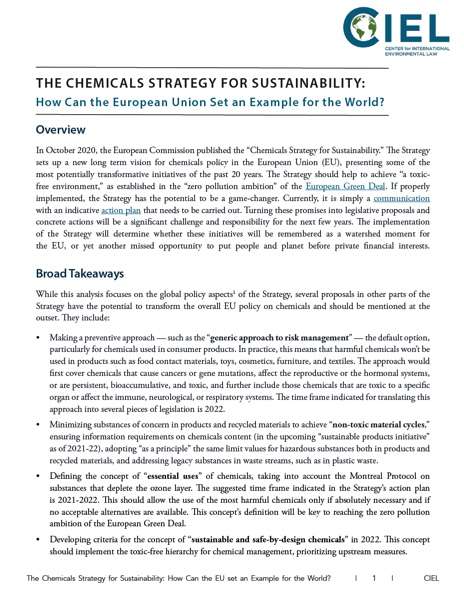
In October 2020, the European Commission published the “Chemicals Strategy for Sustainability,” which sets up a new long-term vision for chemicals policy in the European Union (EU) and presents some of the most potentially transformative initiatives of the past twenty years. The Strategy should help to achieve “a toxic-free environment,” as established in the “zero pollution ambition” of the European Green Deal.
If properly implemented, the Strategy has the potential to be a game-changer. Currently, it is simply a communication with an indicative action plan that needs to be carried out. Turning these promises into legislative proposals and concrete actions will be a significant challenge and responsibility for the next few years. The implementation of the Strategy will determine whether these initiatives will be remembered as a watershed moment for the EU, or yet another missed opportunity to put people and planet before private financial interests.
Several proposals within the Strategy have the potential to transform the EU policy on chemicals. They include making a preventative approach — such as the “generic approach to risk management” — the default option, particularly for chemicals used in consumer products, meaning harmful chemicals would not be used in products such as food contact materials, toys, cosmetics, furniture, and textiles; minimizing substances of concern in products and recycled materials to achieve “non-toxic material cycles”; defining the concept of “essential uses” of chemicals, taking into account the Montreal Protocol on substances that deplete the ozone layer; strengthening commitments on endocrine disrupting chemicals (EDCs) by developing a legally binding hazard identification that applies across legislation and includes provisions that will ban EDCs from consumer products; and restricting persistent poly- and perfluoroalkyl substances (PFAS) for non-essential uses.
Our analysis focuses on the global policy aspects of the Strategy, laying out the EU’s commitments toward global chemicals management and detailing practical steps to achieve these commitments over the next few years. They include:
- Ensuring that hazardous chemicals banned in the EU are not produced for export;
- Having a leading role and promoting the implementation of existing international instruments (such as the Stockholm, Rotterdam, and Minamata Conventions);
- Building capacity to assess and manage chemicals safely in third countries, including through cooperation with Africa;
- Promoting the implementation of the Globally Harmonized System of Classification and Labelling of Chemicals (GHS) and introducing new criteria/hazard classes;
- Meeting the 2030 Agenda’s goals for the sound management of chemicals, and adopting strategic objectives and targets for the sound management of chemicals and waste beyond 2020 (such as in the context of SAICM beyond 2020).
Read the full analysis:
